Install PHP on Windows
PHP for Windows provides users the ability to run nearly any PHP script desirable. Windows can tackle a wide range of software, from your PHP scripts to the many content management systems such as WordPress or Drupal.
Since Windows does not come already equipped with PHP, it does require some additional steps to install. This article will walk you through the process of how to effectively install PHP on Windows 2016 through the use of the Windows PHP 7 Installer.
Preflight
Before you can begin your PHP installation, you will need to determine if your server has our Fully managed Plesk control panel, or is one of our self or core managed options (without Plesk).
- You can determine whether your server has Plesk by logging into https://manage.liquidweb.com.
- Once you have successfully logged in, expand your server from the “Overview” page.
- Next, look to the far right of the “Log into your server” heading, and locate the word “Plesk.”
If “Plesk“ is not listed, you do not have Plesk installed. Manually install PHP using the steps below (without the use of Plesk). If your server has Plesk installed, you can add PHP support through Plesk directly.
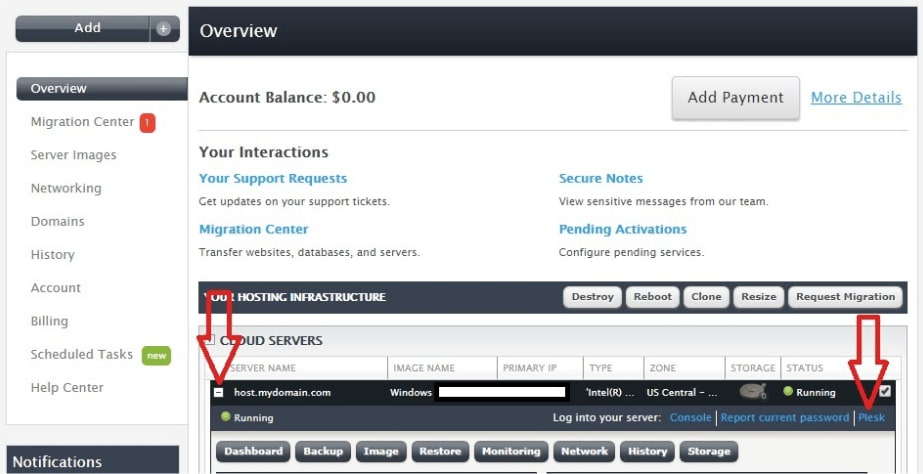
The following information provides a step by step breakdown of each installation process. This article will provide steps for Windows Server 2016 and Plesk Onyx (if you have Plesk currently installed). Use these same steps as a guideline for Windows Server 2008 or 2012. Besides, the older versions of Plesk will use similar steps.
As with any managed Liquid Web server, as a valued customer, if you do not feel comfortable performing the PHP software installation independently, please contact our support team for additional assistance. Liquid Web support will be happy to walk you through the steps, answer any questions you may have, or complete the installation for you if needed.
Installing PHP using Plesk
To install PHP using Plesk, you will navigate through the Updates and Upgrades option within Plesk. This method will automatically download and install PHP directly from the Plesk Control Panel. Listed are the steps to install PHP using Plesk:
- Login to Plesk as the admin user.
- Choose Tools & Settings, then select Updates and Upgrades.
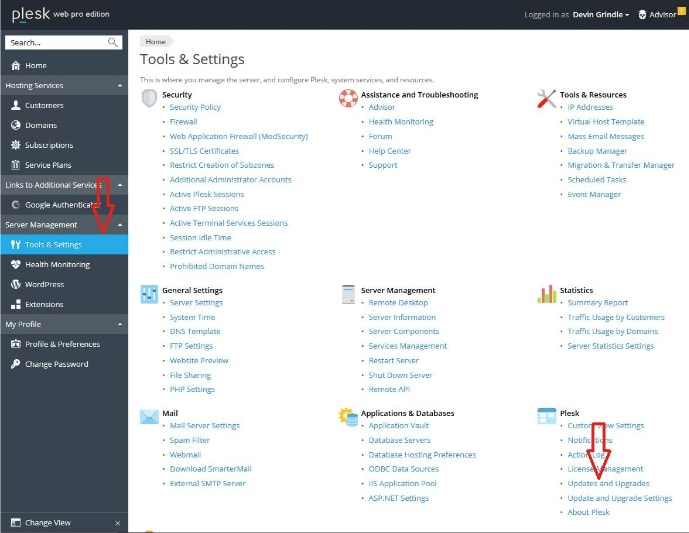
- Click Add/Remove Components.
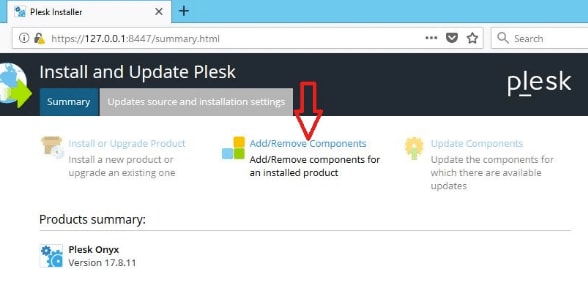
- From the Add and Remove Product Components page you will need to expand the Plesk hosting features. Select install next to the desired PHP version. Click Continue and you will see the installation process finish.
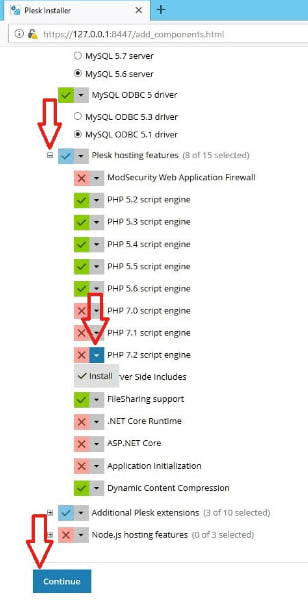
Once PHP has successfully installed, it will require enabling on a per domain basis. To enable PHP through Plesk, follow these steps:
- From Plesk, choose Domains on the left-hand side.
- Select your domain name.
- Choose Hosting Settings.
- Under Web Scripting and Statistics check the box to Enable PHP.
- Select the proper PHP version next to PHP support.
- Click OK.
That’s it! You are now ready to verify that PHP is working.
Installing PHP Without Plesk
There are several ways to install PHP on Windows Server 2016 (without Plesk). Since the manual method is more complex and requires manual configuration to IIS, the recommended approach is using the Web Platform Installer. The Web Platform Installer will automatically download PHP and will configure the IIS handlers for you.
To install PHP using the Web Platform Installer, follow the steps provided below:
- Connect to your server using RDP with an Administrator user.
- Open Internet Information Systems (inetmgr.exe).
- Select the server name (under “Start Page” on the left-hand side of IIS).
- Choose “Get New Web Platform Components” from the Actions pane.
- If the Web Platform Installer is not already installed you will be directed to a website to install the Web Platform Installer.
- Download and run the Web Platform Installer.
- You can now select “Get New Web Platform Components” from the Actions pane and proceed with step 5.
- If the Web Platform Installer extension is already installed, it will open.
- If the Web Platform Installer is not already installed you will be directed to a website to install the Web Platform Installer.
- From the Web Platform Installer search for “PHP 7”.
- Select the version of PHP that you wish to install and click “Add”, “Install”, “I Accept”
- After the installation completes click “Finish”.
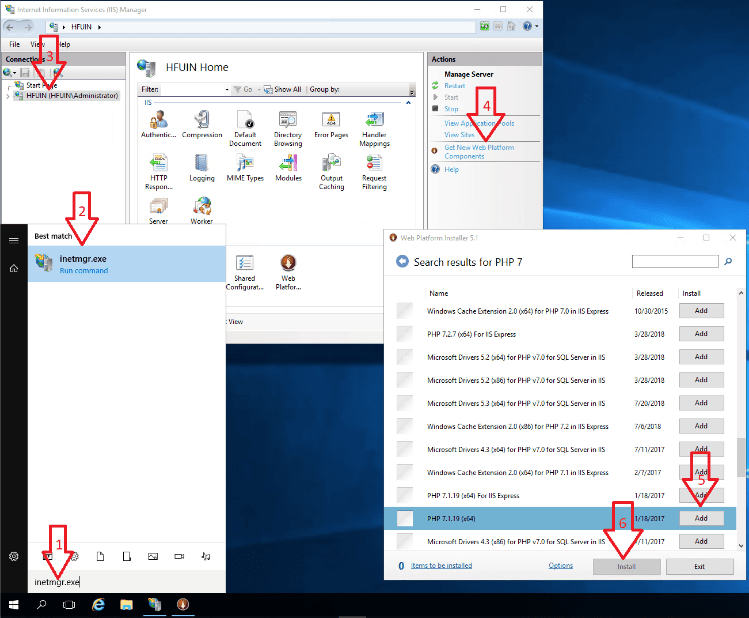
Verify PHP is Working
Once you have PHP installed, the next step is to verify that PHP is working correctly. You can do this by adding any PHP script to the website and manually navigating to the page in your browser. The following steps explicitly explain the process of how to create a PHP page under a site in IIS. This process will then result in the output of information about PHP’s configuration. Commonly referred to as a “PHP info page,” we show you the steps needed to create one:
- Connect to your server using RDP with an Administrator user.
- Open Internet Information Systems (inetmgr.exe).
- Expand the server name (under “Start Page” on the left-hand side of IIS).
- Expand “Sites”.
- Right click the site name and choose “Explore”.
- Within the directory that opened create a file named phpinfo.php with the following contents:
<?php
phpinfo();
?> - Navigate to the site specifying the phpinfo.php we created. Example : http://domain.com/phpinfo.php
- If everything went well you should be shown a page that displays the PHP version and other information.
- Delete the phpinfo.php file we created earlier.
 Now that PHP is installed and working correctly you are ready to upload your code or get started with one of many PHP based content management systems of your choice.
Now that PHP is installed and working correctly you are ready to upload your code or get started with one of many PHP based content management systems of your choice.
Related Articles:

About the Author: Devin Grindle
Our Sales and Support teams are available 24 hours by phone or e-mail to assist.
Latest Articles
In-place CentOS 7 upgrades
Read ArticleHow to use kill commands in Linux
Read ArticleChange cPanel password from WebHost Manager (WHM)
Read ArticleChange cPanel password from WebHost Manager (WHM)
Read ArticleChange the root password in WebHost Manager (WHM)
Read Article


